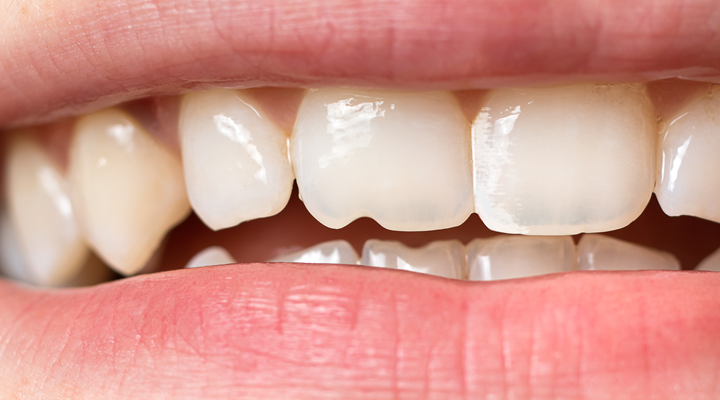
Have you ever noticed white spots on teeth and wondered what they are or where they came from? You’re not alone.
White spots on teeth can seem concerning, but they’re not always a sign of serious dental issues.
In this blog, we delve into the various causes for white spots on teeth and explore effective solutions to address them.
Causes of white spots on teeth
There are a number of causes behind white spots on teeth, including:
Fluorosis: Fluorosis commonly appears as discolored lines across the middle or bottom of teeth. This can also appear as white spots on teeth. According to the American Dental Association, fluorosis occurs when younger children consume too much fluoride, from sources such as toothpaste or fluoridated drinking water, over a long period of time. While it may seem concerning, “Fluorosis isn’t a disease and doesn’t affect the health of your teeth. In most cases, the effect is so subtle that only a dentist would notice it during an examination.”
Be sure to talk with your child’s dentist if you’re concerned about any white spots on their teeth.
Enamel hypoplasia: Enamel hypoplasia occurs when the hard outer layer of your teeth, called enamel, doesn’t develop properly. This can lead to discoloration, including white spots on teeth.
There are many reasons an individual may develop enamel hypoplasia. Inherited conditions, pregnancy-related problems, and medical problems such as celiac disease can increase your risk of developing the condition.
If untreated, enamel hypoplasia can lead to dental problems such as cavities, tooth sensitivity, tooth erosion, and a misaligned bite. Treatment for enamel hypoplasia includes the use of sealants, fillings, crowns, or even extractions.
Poor dental hygiene: When oral hygiene practices such as brushing and flossing are neglected, plaque—a sticky film of bacteria—accumulates on the teeth. This plaque contains acid-producing bacteria that thrive on leftover food particles and sugars in the mouth.
Over time, the acids produced by these bacteria can erode enamel, causing demineralization. This demineralization process can result in the formation of white spots on teeth, which are indicative of areas where minerals like calcium and phosphate have been lost.
Note: Having orthodontic attachments such as braces can increase your risk of demineralization of the teeth. Be sure to talk to your orthodontic team about the correct way to care for your teeth during treatment.
Medications: Certain medications can contribute to the development of white spots on teeth, particularly if they affect tooth development during childhood. Common examples of medications that have been associated with tooth discoloration include tetracycline, salmeterol and fluticasone, and amoxicillin.
According to an observational analysis from Frontiers in Pharmacology, a study “revealed that certain drugs are significantly associated with tooth discoloration. Caution should be exercised when using these drugs, especially during pregnancy and early childhood.”
Always consult with your dentist and medical team if you have any concerns about medications and your oral health.
Treatments for white spots on teeth
Treatment options for white spots on teeth depend on the underlying cause and severity of the condition.
Here are some common treatment approaches:
Fluoride treatment: If white spots are caused by early-stage enamel demineralization or dental fluorosis, your dentist may recommend fluoride treatments to help remineralize the enamel and reduce the appearance of white spots. These treatments involve applying fluoride varnish, gel, or foam to the teeth, which helps strengthen the enamel and make it more resistant to acid erosion.
Microabrasion: Microabrasion is a minimally invasive dental procedure that involves removing a thin layer of enamel from the surface of the teeth to eliminate superficial white spots and discolorations. This procedure is often combined with enamel-strengthening treatments like fluoride to achieve optimal results.
Dental bonding: Dental bonding, also known as composite bonding, involves applying a tooth-colored composite resin material to the surface of the teeth to cover up white spots and improve their appearance. The resin is carefully sculpted and bonded to the enamel, providing a natural-looking result.
Veneers: Veneers are thin, custom-made shells made of porcelain or composite resin that are bonded to the front surface of the teeth to mask imperfections such as white spots, discolorations, and minor enamel irregularities. Veneers offer a durable and long-lasting solution for improving the appearance of white spots on teeth.
White spots on teeth are generally not a cause for concern
White spots on teeth can be concerning, but they’re not always permanent or indicative of serious dental problems. By understanding the underlying causes and adopting effective preventive measures and treatment options, you can maintain a healthy, vibrant smile.
If you’re concerned about white spots on your teeth, don’t hesitate to consult with your dentist for personalized guidance and recommendations tailored to your oral health needs.
